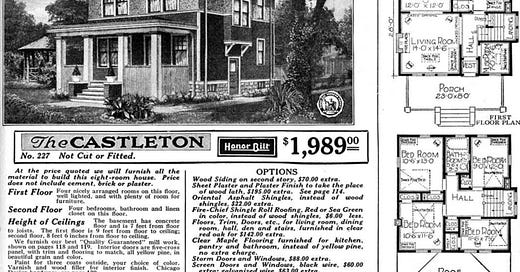Part 2: I am Going to Bring Back the Sears Home
There are 4 necessary ingredients for success of Mail-Order Housing: Architecture, Land, Supply Chain, and Capital, in that order
SERIES STRUCTURE
Part 1: The Case for Mail Order Housing
Part 2: The 4 Necessary Ingredients for Re-Launch of Mail-Order Housing
Part 3: What the Pilot for Mail Order Housing Looks Like
PART 2: THE 4 NECESSARY INGREDIENTS FOR RE-LAUNCH OF MAIL ORDER HOUSING
THE PACKING PROCESS
There are a few principles I follow when attempting to launch anything new.
First, whenever you are trying to do something complex, eliminate variables.
Second, the path from zero to one is far harder than one to two.
Both of these yield the need to answer one critical question: “What is the minimum viable product?” followed by “How can we most simply engineer that minimum viable product?”
When applied to mail-order housing, these principles take an otherwise extremely complex business and boil it down to four necessities: Land, Architecture, Supply Chain, and Capital.
These necessities are to be addressed linearly because each precedes the other:
With land, zoning informs the architecture
With architecture, takeoffs inform the supply chain needs
With supply chain needs, a budget is created, informing capital requirements
Procedurally, this isn't all that different from a traditional stick-built home. The major innovation - an attempt to pull the sword from the stone - is the radical overhaul of the supply chain. Packing an entire home into a single container is new, novel, and nuts.
Packing an entire home into a single container is new, novel, and nuts.
Pondering this exercise, I took a small Allison Ramsey cottage (The Wharf) and Sears-ed it up. Doubling down, we even took the anachronistic Groucho-Marx syntax from the 1920s marketing catalog (the cat’s meow! the bee's knees!) and updated it for modern amenities.
I then sought to find how much house would fit inside a single stock 20’ container. The (very) rough findings? I can pack a 500-sf cottage in a standard 20-foot container. Maybe more. The contents include everything except the foundations, mechanicals, and plumbing pipe.
That’s a lot of stuff in a small area. It’s basically an uber-efficiently flat-packed IKEA model on steroids.
What’s in the Box? Everything needed to construct the Wharf cottage, minus the foundation (which is too variable by project), and items that need to be licensed trade supplied like mechanical HVAC equipment and plumbing pipe. Everything else, from framing to cabinetry, sheetrock, flooring, windows, doors, roofing, and fixtures, is in there.
THE MAIL-ORDER REVOLUTION
Container-packing a new home could be revolutionary on a couple of levels:
Mail-order homes are perfect for small builders, including affordable home builders, who could eliminate the inevitable 100 trips to Lowe’s that burden each and every house (Click “purchase” button -> house show up -> build house). This eliminates substantial waste, saving money, time, and misery.
Mail-order homes are superior for building in remote areas far from supply houses. Those Lowe’s trips are particularly brutal if you are building in Northwest Nebraska or deep in the Smokies. But a truck can deliver a fully pre-specified home in a single container, with all the parts numbered, anywhere in the world, and hundreds of trips are eliminated.
Lastly, container-packing gets around the fatal modular/manufactured problem, where a builder has to deal with inspectors in two locations (factory and site), which can become logistically and cost-prohibitive, particularly on small projects.
I have always believed that a viable model was here. And the exercise described above only made me more sure of it. It needs a major supplier or network to back the idea.
I can imagine a future where a supply house has a dozen pre-packed containers ready to go and could custom pack containers with a 1-2 week lead time. Builders, framers, and trim carpenters would love it.
As my friend Sam Bayer coached me, business is all about identifying constraints. The constraints here? The rebirth of mail-order housing is a huge operational lift to pilot and requires a fairly big capital raise. A pilot requires a builder/developer with land, too. It’s a slightly bizarre amalgamation of tech and development, and the start-up world and land development don’t overlap a lot, and there are a lot of failed companies in that overlapping space.
I’ll open source how I would prove the model in Part 3.








